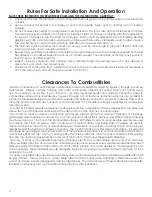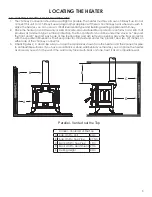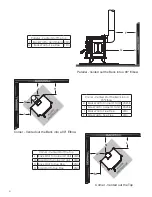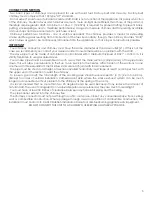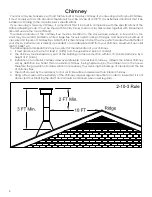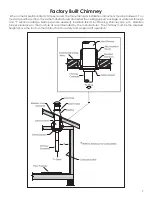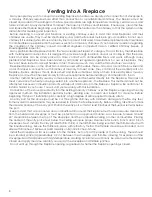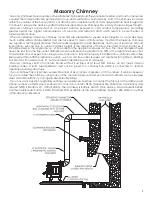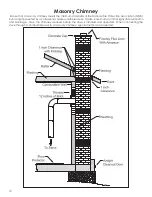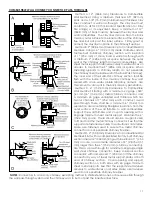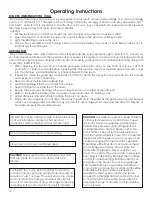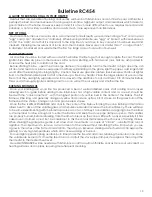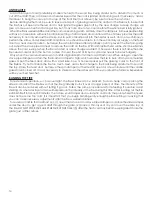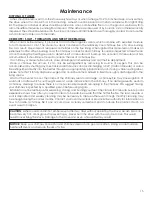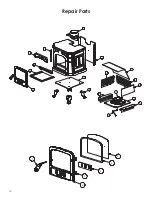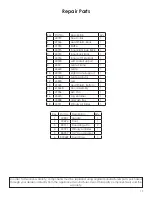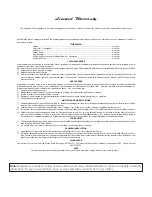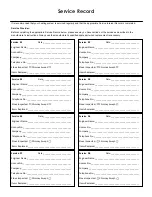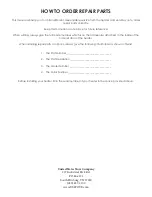
12
FUEL RECOMMENDATIONS COAL
Most sizes of bituminous coal will work in your heater; for best results we recommend large nut coal to small egg
coal (1-3/4” diameter to 4” diameter). When burning anthracite, use egg or broken with sizes between 2-5/16”
and 4-3/8”. Note that it is important to the life of your stove to buy coal which has been sized and cleaned.
Cleaning insures removal of rocks and other materials.
Lighting
1. Set the thermostat on “HIGH” and open the spin damper on the feed for maximum draft.
2. Open the feed door and place paper and wood kindling on the grate for starting the fire.
3. Light the kindling and close the door.
4. Once a fire is established and burning briskly, add approximately 15 pounds of coal, being careful not to
smother out the kindling fire.
ADDING FUEL
When maintaining a fire, add small amounts of fuel periodically as required (enough to burn for 3 to 5 hours). As
you become more familiar with the operation of your heater, it is possible to add coal to burn for longer durations
of 8 to 10 hours. But doing so carelessly will promote incomplete combustion and considerable sooting along with
a very dirty, inefficient fire.
1. When opening the feed door, turn handle and open door until it stops on the latch and leave it at that
position for at least 10 seconds before opening fully. This will allow any accumulated gases or smoke to exit
into the chimney, eliminating flame or smoke spillage into the room.
2. If need be, shake the grate vigorously back and forth to dump the ashes into the ash pan. Do this at least
once every 12 hours of operation.
3. Never smother the fire when adding fuel.
4. Add fresh kindling if the bed of coals has cooled.
5. Never add fuel above the top of the liners.
6. Be sure the new fuel is burning before you close the door and adjust combustion air.
7. Refer to the Bulletine RC454 in this manual for more information on burning coal.
8. Adjust dampers and air shutters to obtain the burn you desire.
9. Empty ash pan regularly. Do not allow the ashes to build up to the grate as the grate will warp and burnout
will occur. Allowing ashes to build up may also result in ash spillage when removing the ash pan. Dispose of
hot ashes properly (See Maintenance).
Operating Instructions
CAUTION:
Hot while in operation. Keep children,
clothing, furniture away. Contact may cause
skin burns. Never use gasoline, gasoline-type
lantern fuel, kerosene, charcoal lighter fluid,
or similar liquids to start or “freshen up” a fire
in this heater. Keep all such liquids well away
from the heater while it is in use. Do not operate
this heater with the feed or ash door open. This
heater is designed for thermostatic operation.
Operating with either door open will overheat
and damage the heater. Always close the
doors after the ignition. Never over-fire your
stove. If any part of the stove starts to glow red,
over firing is happening. Readjust the air intake
control to a lower setting. Build fires directly on
the grate in the heater. Do not burn garbage,
flammable fluid such as gasoline, naphtha or
motor oil. Do not store fuel or other combustible
materials within the minimum clearances
specified in this manual or within the space
required for charging and ash removal. Doing
so could result in a house fire. Never alter the
adjustment range or air inlets to increase firing
for any reason.
Do not use manufactured or charcoal logs
DO NOT burn coke, charcoal, high volatile bituminous
coal, sub bituminous, lignite or channel coal
(sometimes called channel coal or candle coal).
Store coal in a dry, well ventilated area.
CAUTION!
Never use the manufactured coal bricks
that are made from coal dust and a wax type
binder.
For the first few burns, build small fires to allow the
cast iron components and painted cabinet parts to
season or cure. Your new stove will emit some smoke
and odors from the curing process but should only
do so for a short period of time. We suggest opening
a window in the room of which the unit is installed.


